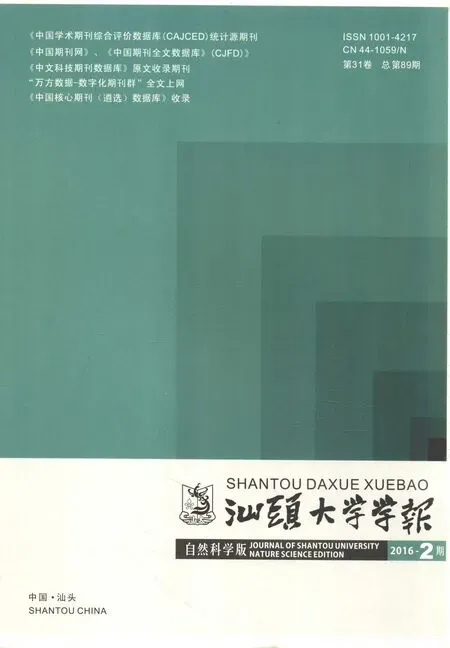Linearly Tetrameric Water Cluster Stabilized by Cyano Groups of Multicomplex[Zn(2,2'-bipyridine)3][Zn(CN)4]·2H2O
CAO Peng,HE Jun(School of Chemical Engineeringand Light Industry,GuangdongUniversityof Technology,Guangzhou 510006,Guangdong,China)
Linearly Tetrameric Water Cluster Stabilized by Cyano Groups of Multicomplex[Zn(2,2'-bipyridine)3][Zn(CN)4]·2H2O
CAO Peng,HE Jun
(School of Chemical Engineeringand Light Industry,GuangdongUniversityof Technology,Guangzhou 510006,Guangdong,China)
Ahydrothermal reaction ofZn(CN)2,2,2'-bipyridine(bipy)afforded a novel multicomplex,[Zn(bipy)3][Zn(CN)4]·2H2O(1),which features a 2D supramolecular network assembled from unprecedented linear water tetramers and anionic[Zn(CN)4]2-moieties through intricate hydrogen bonding interactions.Single-crystal X-ray diffraction,FT-IR,thermogravimetric analysis and photoluminescence spectrum of 1 also have been discussed.1 exhibits strong photoluminescence maximized at 437 nm upon 310 nm excitation at ambient temperature,of which is close to that of the greenish light.
water clusters;zinc(II)multicomplex;2,2'-bipyridine;cyano group;photoluminescence
O 6-3Document code A
Recently,investigations on the syntheses,structures and properties of‘discrete'water clusters and polymeric water aggregates in crystal lattices of inorganic or organic coordination compounds have attracted considerable attention,not only because of their unique properties in constitution materials but alsobecause oftheir important roles in biological,chemical and physical processes[1-4].A detailed understanding of the possible structures and stabilities of water clusters can help to build more higher nuclearity water clusters.To date,numerous discrete and varied size oligomeric water clusters including trimers,tetramers,pentamers,hexamers etc[5-7],have been documented.Although these researches provide significant information for the aggregation ofwater molecules in different environments[8],however,water clusters coexistingwith coordination complexes are rarely being reported[9].Furthermore,water tetramer as one of the most important subsets of water clusters is of great interest owing to its small number aggregation but various isomers[10].Misako etc[11]have enumerated the topology-distinct isomers for water tetramer on the basis of the abinitio MO method at the HF/6-31G*level of theory(Scheme 1).Theoretically,thelinear type of water tetramer is the least stable energy state,and thus it is difficult to separate experimetally.
Enlighted by Bernal's[12]work that cyano groups are good candidates for the construction of water clusters,herein we carried out the analogous synthesis.In attempt to obtain the crystalline solid embedded water clusters,Zn(CN)2is employed as the cyano resource.As expected,a novel multicomplex[Zn(bipy)3][Zn(CN)4]·2H2O(1),which including an unprecedented linear water tetramer,was afforded.
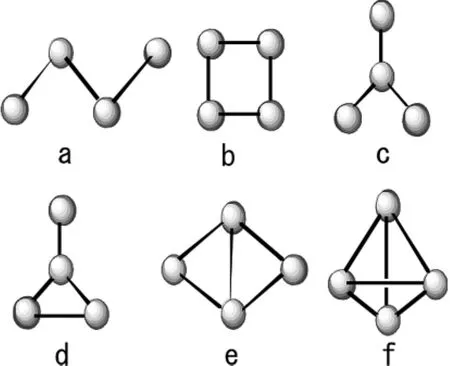
Scheme 1 Six possible topologies ofwater cluster(H2O)4isomers[11].
Ahydrothermal reaction ofZn(CN)2,bipyin 2:3 molar ratioat 140°C gave complex1[13].X-ray single crystal diffraction analysis[14]confirms that the framework of1 consists of[Zn(bipy)3]2+cationic moiety,[Zn(CN)4]2-counter anion and two crystalline water molecules(Figure 1).As shown in Figure 1,according to their coordination numbers,the metal centers can be sorted into two coordination fashions(Zn1&Zn2),of which the Zn1 in cationic moiety is coordinated by six nitrogen atoms from three chelating bipy(Zn1-N 2.132~2.184 Å),and the Zn2 is surrounded by four carbon atoms from four independent cyano groups(Zn2-C 2.017(5)~2.036(4)Å). By the metal-centered angles(Zn1 106.76~111.17°,Zn2 76.03~168.81°),Zn1 in[Zn(bipy)3]2+adopts a distorted octahedron geometry owing to the fact that the ligands bite are too short to form a perfect octahedral configuration,and Zn2 is assumed to be tetrahedron coordination geometry.Moreover,in the cell packingdiagram,these ionic units stack in a-ABAB-pattern,which
are inter-connected by intricate supramolecular interactions(including electrostatic and-stack interactions)to construct multi-dimensional network(Figure 2).
More interestingly,an anionic hydrogen-bonding network is assembled from linear water tetramer in 1.In combination oftwolattice waters(O1Wand O2W)and their crystallographically symmetric molecules give a zigzag water chain(H2O)4(Figure 3).In such chains the O…O distances are in range of2.792~2.818 Å,which are comparable to that of liquid water(2.852 Å)and Ihice(2.759 Å).However,the angle of O1W…O2W…O2W(123.33°)in 1 is much largerthan the tetrahedral angle found in ice Ihand Ic(104.45°).Accordingtothe calculation ofenergy state,the linear type of water tetramer should be relatively in stable configuration,but the cyano ligand with one atom uncoordinated,as expected,will help to stablize it via OW-H…N bonds. Distances between O1W and cyano nitrogen(O1W…N 2.908-2.986 Å)indicate a moderate strength of the bonds.Assembly from tetrameric water chains and[Zn(CN)4]2-frameworks,an anionic 2D H-bonding network,can be fused into 14-membered rings consisting of ten water molecules and four anion complexes(Figure 3).
The FT-IR spectrum of 1 presents a relatively sharp band centered about 3 482 cm-1and 3 543 cm-1,which should be attributed to O-H stretching vibration frequency of water molecules in 1.This further confirmed the presence of the water clusters(υO-H=3 490 and 3 280 cm-1)in complex 1.At the same time,the FT-IR spectrum of 1 also appears a maximum absorption at 2 050 cm-1and this is assigned to the stretching vibration of C≡N groups,which is in good agreement with the analysis of crystal structure.
Thermogravimetric(TG)curve of1 was performed in N2atmosphere,shown in Figure 4,and it can be divided intothree major weight loss steps.The first step in the range from50°Cto98°C with a total loss of 5.20%,is much close to the calculated ratio(4.87%)of the guest water molecules.No further decomposition in the range of 98°C-250°C suggests that the dehydrated framework formulated as[Zn(2,2'-bipyridine)3][Zn(CN)4]and remained stable below 250°C. When heated up to about 250°C,the framework started to collapses and decompose organic components,which indicates the contribution of the water tetramer to the stability of the crystal structure.
The photoluminescence emission(PL)spectra of complex 1 was measured in the solid state at room temperature.It displays an intense photoluminescence,with an emission maximum at 437 nm,upon excitation at 310 nm at room temperature(Figure 5).For comparison,we also analyzed the photoluminescense properties of the corresponding free ligand 2,2'-bipy and found the main emission peak at 535 nm under the irradiation of ultraviolet light at 347 nm in the solid state.The emission energy of complex 1 that occurs much higher radiation than that of free ligand may be attributable to the highly conjugated systems and intraligand-*transition of 2,2'-bipy in 1.And the blue shift of emission peak of 1 probably caused by the twisted linker conformation and framework rigidity[15-16].
In summary,we have characterized a linear tetrameric water cluster trapped in the multicomplex.This investigation is likely to yield insight into the properties of water in various environments,especially mimic the anomalous character of water in living systems as well as in the study of synthetic models.In addition,solid 1 behaves photoluminescent and thermostable,recommending the potential use in materials field[17-18].
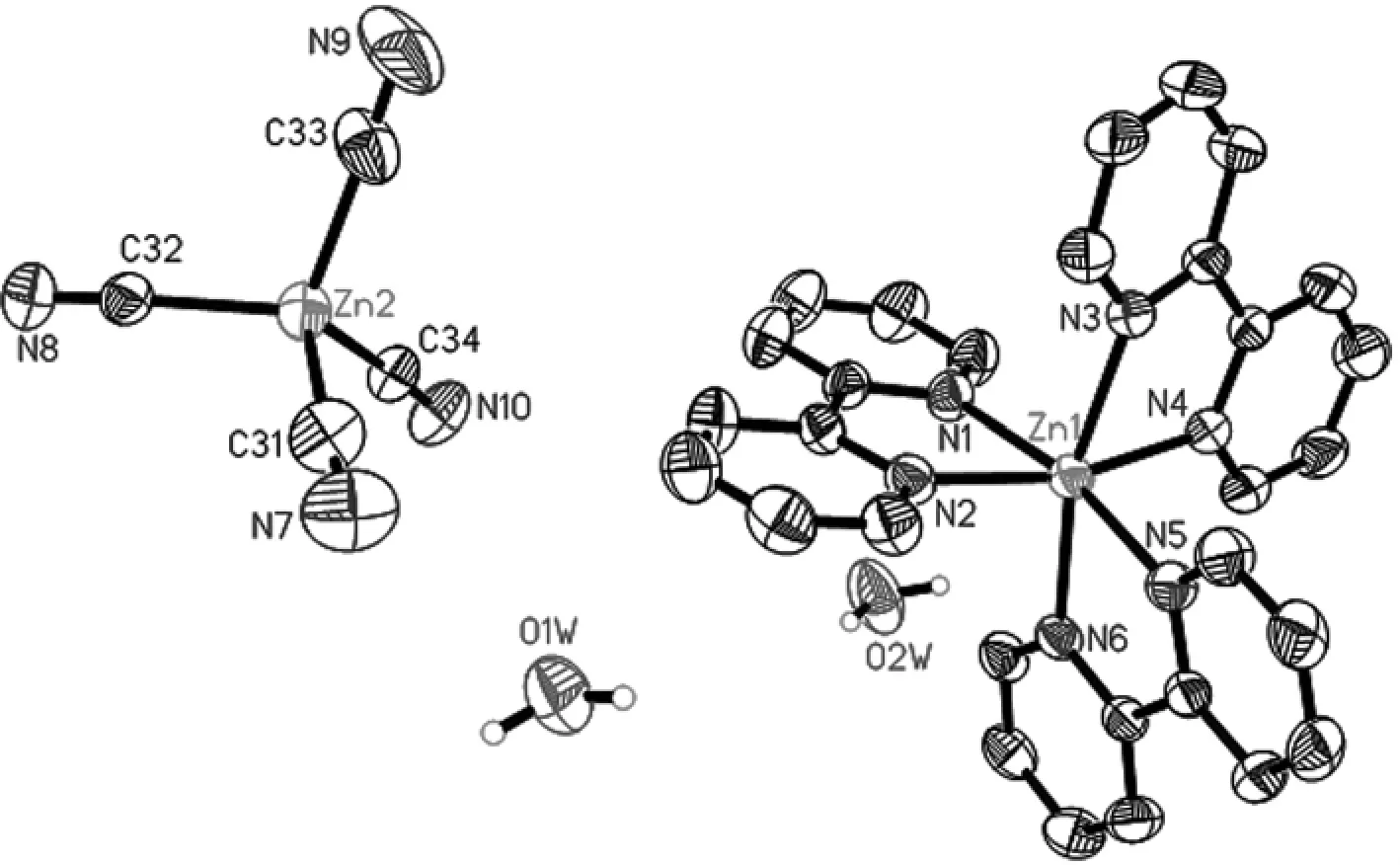
Figure 1 An ORTEP view of 1(30%thermal probability ellipsoids)with H atoms omitted for clarity.Selected bonddistances(Å)andbondangels(°):Zn(1)-N(1)=2.184(2),Zn(1)-N(2)=2.164(3),Zn(1)-N(3)=2.156(2),Zn (1)-N(4)=2.183(3),Zn(1)-N(5)=2.168(2),Zn(1)-N(6)=2.132(2),Zn(2)-C(31)=2.017(5),Zn (2)-C(32)=2.031(4),Zn(2)-C(33)=2.020(5),Zn(2)-C(34)=2.036(4);N(6)-Zn(1)-N(3)=165.19 (9),N(6)-Zn(1)-N(2)=98.41(10),N(3)-Zn(1)-N(2)=95.02(10),N(6)-Zn(1)-N(5)=76.36(9),N(3)-Zn(1)-N(5)=96.01(9),N(2)-Zn(1)-N(5)=96.39(10),N(6)-Zn(1)-N(4)=92.13(9),N(3)-Zn(1)-N(4)=76.03(10),N(2)-Zn(1)-N(4)=164.64(9),N(5)-Zn(1)-N(4)=96.95(10),N(6)-Zn(1)-N (1)=97.00(10),N(3)-Zn(1)-N(1)=92.38(9),N(2)-Zn(1)-N(1)=75.45(9),N(5)-Zn(1)-N(1)= 168.81(10),N(4)-Zn(1)-N(1)=92.25(9),C(31)-Zn(2)-C(33)=111.17(19),C(31)-Zn(2)-C(32)= 109.97(16),C(33)-Zn(2)-C(32)=109.38(16),C(31)-Zn(2)-C(34)=106.76(16),C(33)-Zn(2)-C (34)=110.84(15).

Figure 2 The cell packing diagram of 1 highlighting the…ABABAB…patternsalongb-axis.
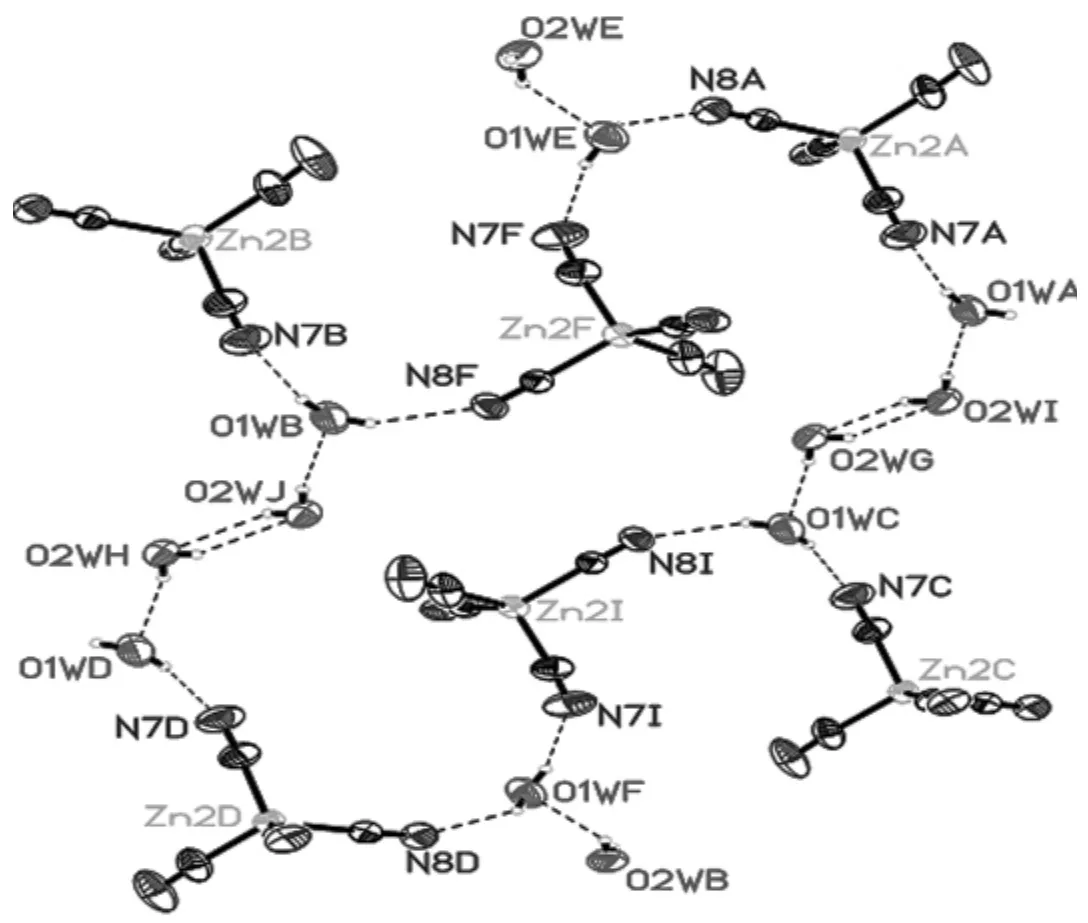
Figure 3 Viewofthe hydrogen-bonding network embedded in 1.
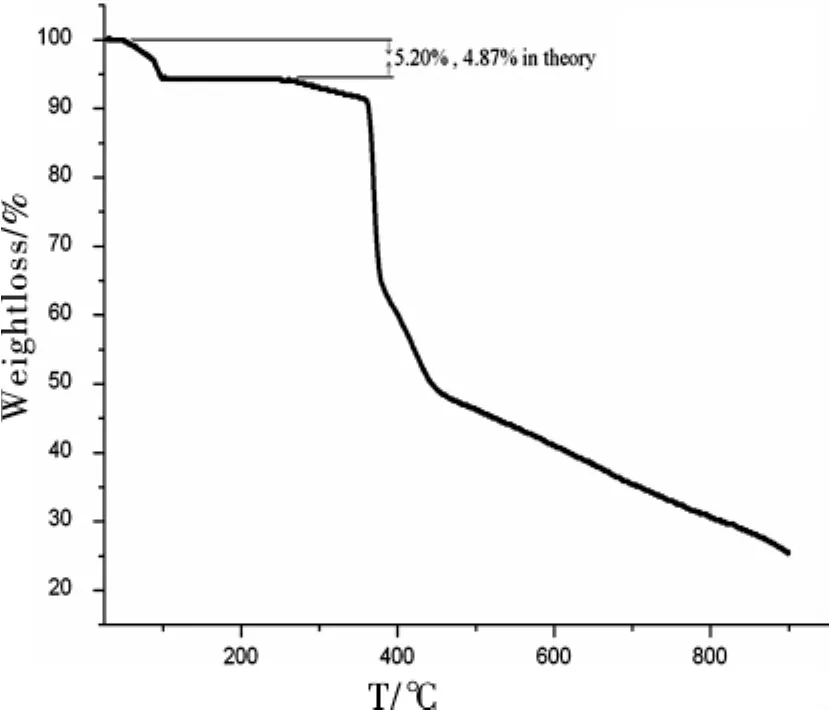
Figure 4 Thermogravimetric curve ofsolid 1.
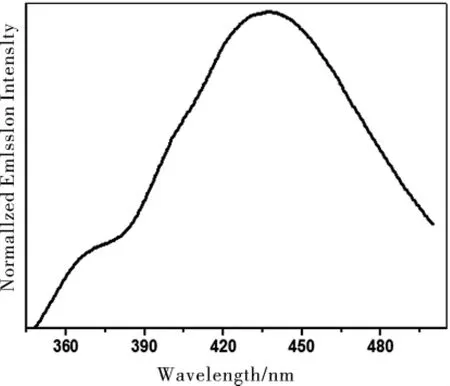
Figure 5 The room-temperature solid-state emission spectrum of 1(λex=310 nm)
Supplementary material
Crystallographic data for complex 1 has been deposited at the Cambridge Crystallographic Data Centre with the deposition number of CCDC 284 631.Copies of this information may be obtained free of charge from The Director,CCDC,12 Union Road,Cambridge,CB2 1EZ,UK (fax:+44-1223-336033;e-mail:deposit@ccdc.cam.ac.uk or http://www.ccdc.cam.ac.uk)or from the corresponding author on request.
Acknowledgements
This work was supported bythe National Natural Science Foundation ofChina(21201042),the Research Fund for the Doctoral ProgramofHigher Education ofChina(20124420120007).
References
[1]ZHAO Q H,CHEN J,ZHU R M,et al.Acyclic water tetramer and discrete(H2O)28cluster with a novel topknot-shaped(H2O)24cluster coexist in the voids of a Ag(I)polymeric solid[J].Inorg Chem Commun,2012,22:182-186.
[2]HANLL,HUTP,CHENJ S,et al.Simultaneous encapsulation ofan infinite T4(0)A(0)6(0)water tape and discrete water hexamers in a hydrogen-bonded Ag(I)supramolecular framework[J].Dalton Trans,2014,43(23):8774-8780.
[3]ALBRECHTL,BOYDR J.Atomic energyanalysis ofcooperativity,anti-cooperativity,and non-cooperativity in small clusters ofmethanol,water,and formaldehyde[J].Comput Thero Chem,2015,1053:328-336.
[4]TADOKOROM,OHHATAYSHIMAZAKI Y,et al.Anomalous enhancement ofproton conductivityfor water molecular clusters stabilized in interstitial spaces of porous molecular crystals[J].Chem Eur J,2014,20 (42):13698-13709.
[5]BUCHANAN E G,ZWIER T S.Binding water clusters to an aromatic-rich hydrophobic pocket:[2.2.2]paracyclophane-(H2O)n,n=1-5[J].J Phys Chem A,2014,118(37):8583-8596.
[6]PRADZYNSKI C C,DIERKING C W,ZURHEIDE F,et al.Infrared detection of(H2O)20isomers of exceptional stability:a drop-like and a face-sharing pentagonal prism cluster[J].Phys Chem Chem Phys,2014,16(48):26691-26696.
[7]TACHIKAWA H,TAKAdA T.Proton transfer rates in ionized water clusters(H2O)n(n=2-4)[J].RSC Adv,2015,5(9):6945-6953.
[8]KANG Y,LIU Q,YiN W,et al.3D Ni(II)/Cu(II)supermolecular frameworks based on pyridylamine and fumarate co-ligands containing a trinodal(4,5,6)-connected network and a(H2O)16water cluster[J].Chin J Chem,2013,31(2):256-262.
[9]MADY,GUOH F,DONGJ,et al.Unusual self-assembled 1Dtape oftetramers and water-nitrate clusters trapped in a zinc(II)complex:Synthesis,characterization,luminescence and catalytic properties[J].J Mol Struct,2013,1054/1055:46-52.
[10]GE J Y,WANG P,MA J P,et al.A well-resolved cyclic water tetramer in a dinuclear CuII coordination complexbased on 1,2-bis(pyridin-3-yloxy)ethane and capped bypyridine-2,6-dicarboxylic acid[J].Acta Crystallog Sect C:Cryst Struct Commun,2013,69(11):1362-1366.
[11]TOSHIKO MIYAKE MA.Enumeration of topology-distinct structures of hydrogen bonded water clusters[J]. Chem Phys Lett,2002,363(1/2):106-110.
[12]MUKHOPADHYAY U,BEMAL I.Self-assembled hexameric water clusters stabilized by a cyano-bridged trimetallic complex[J].Cryst Growth Des,2005,5(5):1687-1689.
[13]Experiment section:A mixture of Zn(CN)2(0.117 g,1.0 mmol),2,2'-bipyridine(0.234 g,1.5 mmol)and H2O(8.0 mL)was stirred for 10 min in air and then transferred to and sealed in a 15 mL Teflon-lined reactor.The reactor was heated in an oven to140°C for 72 h and then cooled to room temperature at a rate of 5°C·h-1.Yellowish polyhedral crystals were obtained at a moderate yield.Anal.Calcd for C34H24N10Zn2· 2H2O:C 55.23,H 3.27,N 18.94%.Found:C 55.31,H 3.14,N 18.78%.
[14]Crystal data:C34H24N10Zn2·2H2O,M=739.40,293(2)K,monoclinic,P21/n,a=13.5054(8)Å,b=13.2490(8)Å,c=19.7231(12)Å,β=95.8570(10)°,V=3510.7(4)Å3,Z=4,Dcalc=1.399 g·cm-3,μ=1.412 mm-1.21380 reflections collected,7973 independent reflections,Rint=0.0268,Final R indices [I>2σ(I)]:R1=0.0472,wR2=0.1079(R for all data:R1=0.0713,wR2=0.1189).GOF on F2=1.005.X-ray data were collected on Siemens SMART are a diffractometer equipped with a CCD 2D detector,using mono-chromatized Mo Ka radiation[λ=0.71073Å].Absorption corrections were made with the program SADABS and the crystallographic package SHELXTL was used for all calculations.
[15]MA D,LI B,ZHOU X,et al.A dual functional MOF as a luminescent sensor for quantitatively detecting the concentration ofnitrobenzene and temperature[J].Chem Commun,2013,49(79):8964-8966.
[16]WEI Z,GU Z Y,ARVAPALLY R K,et al.Rigidifying fluorescent linkers by metal-organic framework formation for fluorescence blue shift and quantum yield enhancement[J].J Am Chem Soc,2014,136 (23):8269-8276.
[17]GHOSH SK,RIBASJ,EI FALLAH MS,et al.Mn(II)staircase structures stitched bywater clusters to a 3D metal-organic open framework:X-ray structural and magnetic studies[J].Inorg Chem,2005,44 (11):3856-3862.
[18]SPIESH J,LADUCAR L.Asubstituentchange exerts a large dimensionalityand water tetramer morphology difference in luminescent cadmium succinate coordination polymers containing 3-pyridylnicotinamide[J].Z Anorg Allg Chem,2014,640(10):1930-1936.
1001-4217(2016)01-0038-07
[Zn(2,2'-bipyridine)3][Zn(CN)4]·2H2O复配物中线型四聚水簇
曹鹏,何军
(广东工业大学轻工化工学院,广东广州510006)
通过水热合成法,利用Zn(CN)2,2,2'-联吡啶合成出一种新颖的复配物[Zn(bipy)3][Zn(CN)4]·2H2O(1),它的特点是通过复杂的氢键作用,将一种结构新颖的线性四聚体水簇和[Zn(CN)4]2-负电基团连接组装成一种二维超分子网络.并对1进行了包括单晶X-射线衍射、红外、热重以及荧光发射在内的表征与分析.研究发现在室温下310 nm的紫外光激发下,1表现出强烈的荧光发射性质,且发射光波长为437 nm,与绿光非常接近.
水簇;锌(II)复配物;2,2'-联吡啶;氰基;光致发光
2015-04-03
Jun HE,E-mail:g_jhe@126.com
Foundation:the National Natural Science Foundation of China(21201042);the Research Fund for the Doctoral Program of Higher Education of China(20124420120007).

